The Comprehensive Guide to Surfing Flotation Vests
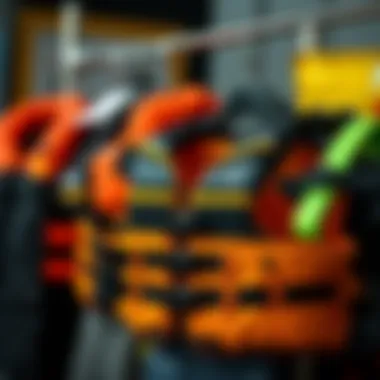
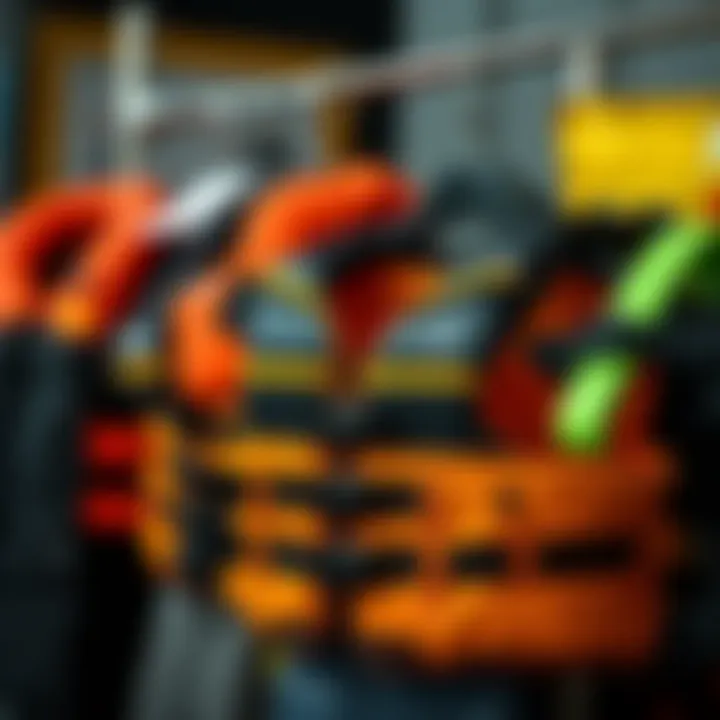
Intro
In the world of surfing, safety is not just a buzzword; it’s a priority, especially when you are out there riding the waves. Surfing flotation vests play a crucial role in ensuring that surfers can enjoy their time on the water while also staying safe. This guide aims to break down the essentials of these vests, from what makes them significant to how to choose the right one for your needs. Whether you're just starting out or have years of experience under your board, understanding flotation vests can enhance your surfing performance and keep you secure.
Gear and Equipment
When it comes to surfing flotation vests, knowing your gear can make a world of difference. You wouldn't hit the waves without your board, right? The same principle applies here. A solid understanding of the equipment can help surfers choose the right flotation vest tailored to their level and style.
Types of Flotation Vests
Surfing flotation vests can vary significantly in terms of design and functionality. Here’s a rundown of the main types:
- Coastal Vests: Thinner and designed for calm waters, these vests offer basic buoyancy without too much added bulk. Great for beginners or casual surfers.
- Impact Vests: These are a step up. Made to protect you from the impact, they give you extra buoyancy and padding. Perfect for those who push their limits.
- PFDs (Personal Flotation Devices): Often equipped with a higher buoyancy level, these vests can help keep you afloat, even in rough waters. They're heavier and bulkier but are ideal in challenging surf conditions.
Essential Features to Look For
When selecting a flotation vest, there are some key features to keep in mind:
- Fit: The vest should feel snug but not constricting. A good fit allows for freedom of movement while still providing safety.
- Material: Look for vests made from durable, lightweight materials. Neoprene is often preferred for its comfort and flexibility.
- Buoyancy: Check the vest's rating. Ideally, it should provide the right amount of flotation based on your weight and skill level.
- Pockets and Additional Mechanics: Some vests come equipped with pockets for convenience, while others may have adjustments for a more tailored fit during a ride. Always consider whether these features add value to your surfing experience.
"There's no substitute for quality when you’re out there in the water. A reliable flotation vest can mean the difference between a good day and a bad one."
In summary, gear selection is pivotal when surfing, and flotation vests are no exception. With the right vest, surfers can navigate waves with a greater sense of security and comfort.
Techniques and Tips
Understanding the functionality of your flotation vest enhances its effectiveness in your surfing endeavors. Here’s how to make the most out of your flotation vest:
Proper Usage
- Always Wear It: It may seem obvious, but always strap on your vest before hitting the water.
- Adjust for Comfort: Make sure you have the vest properly adjusted to your body. Too loose or too tight can either make it ineffective or hinder your movement.
Care Tips
- Rinse After Use: Saltwater can damage materials. A good rinse after every session can extend the life of your vest.
- Storage: Store it in a cool, dry place away from direct sunlight. This helps prevent material degradation.
- Check for Wear and Tear: Get into the habit of inspecting your vest regularly. Any signs of wear could be a safety hazard.
By integrating these techniques into your routine, you not only ensure increased safety but also gain confidence in your surfing skills.
For additional resources related to surfing safety and gear selection, you can consult surf-related forums such as Reddit or educational content from universities at *.edu sites.
Prolusion to Surfing Flotation Vests
Surfing, with its dynamic nature and the thrill of riding waves, is an exhilarating sport that attracts people from all walks of life. However, the ever-changing conditions of the ocean can turn this exciting experience into a risky endeavor without the right precautions. This is where surfing flotation vests come into play. These vests are not just about keeping us afloat; they are essential gear that enhances safety and boosts confidence for surfers of all skill levels.
In a sport where the unexpected can happen in the blink of an eye, wearing a quality flotation vest brings peace of mind. It provides critical support when navigating rough waters, ensuring that surfers can focus on their performance rather than worrying about getting back to the surface. The comfort and functionality of these vests can significantly affect a surfer's experience, making them a worthy investment for anyone serious about the sport.
When choosing to engage in surfing, one must recognize that having the right equipment is as vital as mastering techniques. The essential role of flotation vests highlights several key considerations including buoyancy, style and type, as well as durability.
Importance of Flotation Vests:
- Enhanced Safety: These vests help prevent drowning, especially for those not yet confident in their swimming abilities.
- Support in Various Conditions: Whether it’s calm waters or tumultuous waves, these vests can keep a surfer afloat.
- Boost in Confidence: With the reassurance that they won’t sink, surfers feel freer to push their limits on larger waves.
- Protection Against Impact: Many vests are designed with impact-absorbent materials that shield surfers from collisions with their board or other surfers.
Understanding Flotation Devices in Water Sports
Flotation devices, especially in the realm of water sports, serve as critical safety enhancements. These devices are not merely accessories; they are instrumental in preserving lives and allowing individuals to safely enjoy activities that may be inherently dangerous, such as surfing, wakeboarding, and kayaking. In this context, understanding the mechanics and purpose of flotation vests becomes paramount for both seasoned pros and novices. They can significantly increase buoyancy, allowing surfers to stay afloat in case of mishaps, giving them a fighting chance in unpredictable waters.
When diving into the various types of flotation devices, several elements merit attention. Each design caters to specific water conditions and activities. For instance, the buoyancy compensating vests offer various buoyancy levels, providing flexibility based on the surf conditions. Meanwhile, impact vests are built not only for flotation but also for protection against falls. Understanding these types and their nuances empowers participants to choose the right option based on their skill level and the environments they frequent.
The significance of flotation devices does not end with mere survival. They also enhance performance. Surfers who feel secure in their flotation gear can focus more on technique rather than fretting about potential dangers. This leads to a more enjoyable experience, one that's filled with confidence instead of caution. Moreover, the psychological edge provided by proper flotation can be the difference in performance level, especially in competitive environments where every second counts.
Ultimately, the choice and understanding of the right flotation vest hinge on various considerations: user experience, intended use, and specific safety requirements. By delving into historical context and purpose, the information presented here sets the stage for surfers to fully appreciate what modern flotation vests contribute to their sport.
Types of Surfing Flotation Vests
The topic of surfing flotation vests is more than just a safety measure—it encompasses a variety of designs and functionalities that cater to the unique needs of surfers. Understanding the types of flotation vests available is crucial. Each category brings specific designs, materials, and intended uses, thus allowing surfers to select one based on their individual requirements. For novice paddlers just beginning their adventures or seasoned pros tackling competitive waves, the right vest can enhance safety, boost confidence, and even improve performance. Let's take a closer look at the different types of surfing flotation vests, their features, benefits, and who might find them most advantageous.
Buoyancy Compensating Vests
Buoyancy compensating vests, often referred to as BC vests, stand as a pillar in the realm of flotation devices. They're designed to provide a balance between buoyancy and freedom of movement. The primary goal of these vests is to keep the wearer afloat, thus allowing for longer sessions in the water without the anxiety of sinking.
These vests often incorporate adjustable buoyancy. The advantage? You can tune the amount of flotation based on your skill level or the condition of the water. For instance, when you're a beginner, a vest with more buoyancy might give you peace of mind as you familiarize yourself with the waves. Conversely, experienced surfers may prefer less buoyancy for a more natural toss and turn in the water.
Key features of buoyancy compensating vests include:
- Adjustable straps for a snug fit
- Lightweight material to avoid cumbersome feeling
- Durable and weather-resistant fabrication
In short, buoyancy compensating vests are especially beneficial for recreational surfers who want the best of both worlds—a safety net without compromising on their ability to maneuver through the surf.
Impact Vests
Impact vests are another type that many surfers turn to, especially those who find themselves in more aggressive surf conditions. These vests are designed primarily to protect against impact and provide a layer of cushioning during wipeouts. The materials used are resilient, allowing them to absorb shocks that might occur from collisions with the board or the ocean floor.

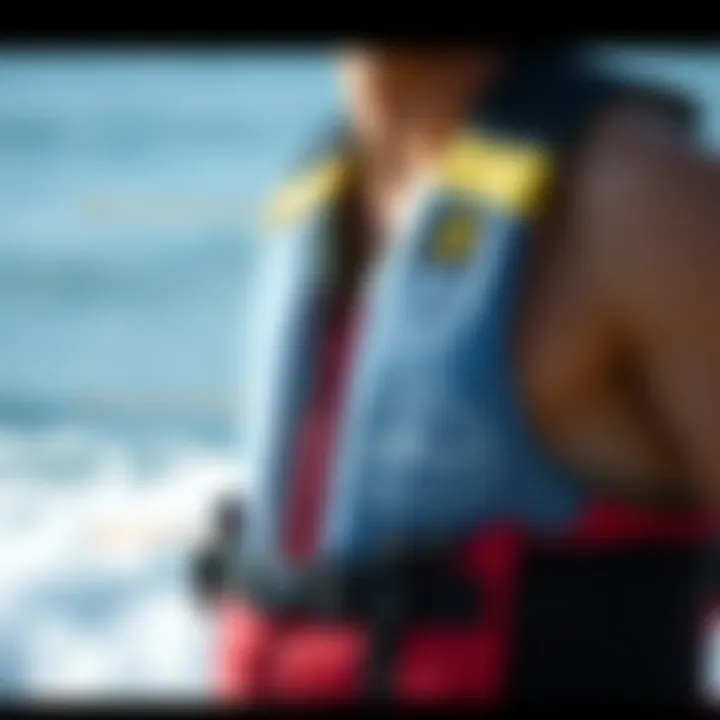
Unlike buoyancy compensating vests, impact vests focus less on buoyancy and more on protection and comfort. They tend to be thinner and fit tightly against the body, enabling flexibility. This snug fit ensures that performance isn't hindered, which is paramount for competitive surfers.
Benefits of impact vests include:
- Enhanced protection against injuries
- Improved buoyancy through strategic foam placement
- Breathable fabrics to ensure comfort during extended wears
Competitive surfers or those frequently navigating harsh conditions often opt for impact vests. They are designed to keep you safe while catching that big wave—you don’t want to focus on getting hurt when all you can think of is riding it!
Hybrid Models
Hybrid models amalgamate the features of both buoyancy compensating and impact vests, making them versatile choices for various scenarios. They provide buoyancy for flotation while also offering a level of protection against impacts, thus appealing to a broad range of surfers.
These vests often incorporate advanced technologies that merge lightweight buoyancy materials with impact-reducing elements. As a result, hybrid models can address the needs of both recreational and competitive surfers while maintaining a lightweight and streamlined profile.
Hybrid model highlights include:
- Adaptability for varying surfing conditions
- Robust design that maximizes both safety and performance
- Stylish aesthetics which can cater to different tastes
Hybrid models are typically the go-to choice for versatile surfers who might switch between leisurely sessions and more competitive environments. Having such a vest means you have the safety and comfort no matter where you surf.
In summary, understanding the different types of surfing flotation vests is crucial for making an informed choice that balances safety, performance, and comfort.
Choosing the Right Flotation Vest
Choosing the right flotation vest is arguably one of the most critical decisions a surfer can make. It's not merely about style or brand; this choice directly influences both safety and performance on the water. A poorly fitting or inappropriate vest can become a liability, potentially hindering movement or, worse, leading to dangerous situations in unpredictable conditions. Thus, understanding the various elements involved in selecting the vest is paramount.
Assessing Buoyancy Needs
When evaluating flotation vests, the first step is assessing buoyancy needs. This aspect isn’t as simple as it may sound; it requires an honest evaluation of your skill level and the types of surfing you engage in. A novice surfer might benefit from more buoyancy to stay afloat, while an experienced surfer might prefer less buoyancy for greater maneuverability.
One must consider the water conditions too—are you hitting gentle waves at a serene beach, or braving the rougher waters further down the coastline? Different surfing scenarios can demand drastically different buoyancy levels.
A practical approach could be:
- Determine what type of surf conditions you will face: Generally, calmer conditions allow for lighter vests, whereas choppy waters often necessitate more robust support.
- Take into account your body weight: Heavier surfers often need more buoyancy compared to lighter individuals due to the physics of floating.
Fit and Comfort Considerations
The fit of a flotation vest is another crucial element. A vest that doesn't fit properly jeopardizes more than just comfort; it affects performance. An overly tight vest can restrict your movements, making it hard to paddle, while a loose vest might shift, becoming a distraction. Wearing the vest for a short trial—especially in a dynamic environment—is alwasy a good idea.
Comfort goes beyond simple sizing; consider the design. Look for features that enhance wearability:
- Adjustable straps: They can help you achieve the custom fit needed for varied body shapes and sizes.
- Flexible materials: These can ensure that you can move freely without feeling constricted.
Ultimately, the right fit plays a vital role in maintaining focus on the waves, not on discomfort.
Material and Durability Factors
The materials used in flotation vests have a significant impact on durability and performance. Look for vests made from high-quality, resistant materials. Neoprene is often favored for its flexibility and insulation, but not all neoprene is created equal. Pay attention to the thickness and type of neoprene used, as some variation can affect both buoyancy and warmth.
Durability is also non-negotiable. Think of the wear and tear flotation vests undergo during surf sessions, which can include:
- Continuous exposure to saltwater and UV rays that can degrade materials over time.
- Abrasion from boards and other equipment.
Hence, when selecting a vest, check the manufacturer’s claims about their materials. Look for quality warranties or guarantees that reflect the vest's lifespan.
By thoughtfully considering these aspects—buoyancy needs, fit and comfort, and material durability—surfers can make an informed decision that both enhances safety and optimizes their performance on the water.
"The right flotation vest is not just an accessory; it's an investment in your surfing experience that ensures both safety and fun."
For futher information on safety standards, consider referencing resources like NPS.gov. Also, forums such as Reddit can offer personal experiences and reviews that may resonate with your specific needs.
Safety Features to Look For
When it comes to choosing a flotation vest for surfing, safety features should be at the forefront of your decision-making process. Simply put, these features not only enhance your chances of survival in the unpredictable waters but also improve your overall comfort and confidence while riding the waves. Surfers, especially beginners, might find themselves in situations where a reliable flotation vest can mean the difference between a thrilling ride and a near-miss. Therefore, understanding the specific safety elements in these vests is critical.
Phantom Technology Explained
Phantom technology is a groundbreaking advancement in flotation vests that focuses on enhancing buoyancy without compromising agility. This tech utilizes air chambers strategically positioned within the vest, allowing for precise buoyancy control. Essentially, it provides just the right amount of flotation to keep you afloat, without feeling cumbersome or overly buoyant.
The beauty of this technology lies in its design, which allows the vest to adapt to the wearer’s movements. When you paddle out, the vest maintains buoyancy and support, but as you dive into a wave or attempt a maneuver, it diminishes its lift slightly to facilitate freedom of movement.
Benefits of Phantom Technology:
- Increased Maneuverability: It allows surfers to twist and turn with ease, making it a perfect balance between safety and performance.
- Customized Buoyancy: Vests equipped with this technology respond to the varying states of water, adapting to calm or choppy waters effectively.
- Reducing Fatigue: A vest that fits well and enhances natural movement reduces physical strain, making longer sessions on the water more enjoyable.
Built-in Reflective Elements
Visibility is key when surfing, especially in the early morning or late afternoon hours when light conditions diminish. Some flotation vests now come with built-in reflective elements that significantly enhance safety. These reflective designs are not just gimmicks; they serve a practical purpose by increasing visibility in low-light conditions.
Imagine riding the waves on a beautiful evening surf, but as dusk settles in, your visibility decreases. A vest with reflective strips or patches can help you remain visible to other surfers or rescue boats. These features can be lifesavers when it comes to communication in the water and preventing collisions.
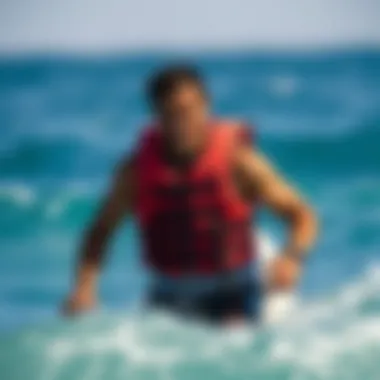
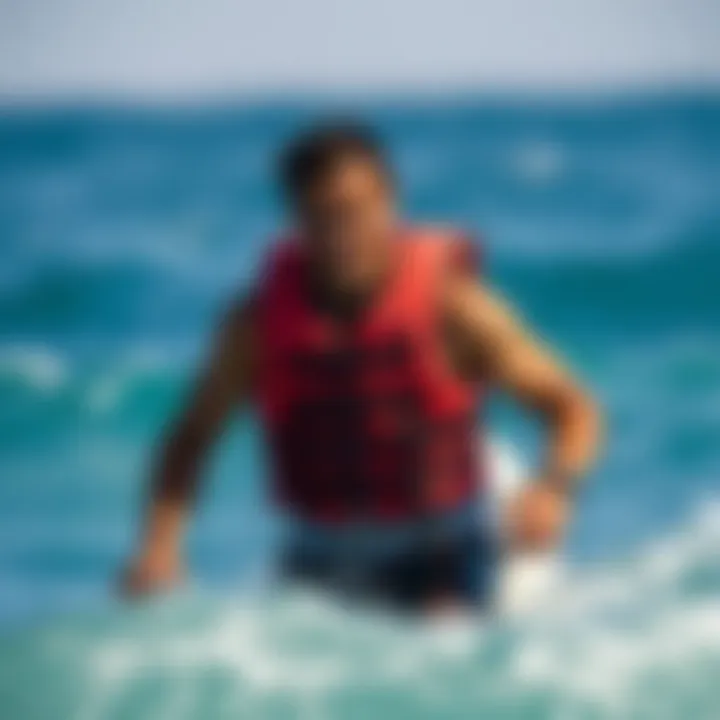
Key Considerations for Reflective Elements:
- Positioning: Ensure that reflective elements are positioned where they can be seen easily, such as on the back and shoulders.
- Quality of Reflection: Not all reflective materials are created equal. Look for high-quality fabrics that offer maximum reflectivity to ensure visibility in all conditions.
- Durability: Check that these elements can withstand wear and tear from the saltwater and UV exposure, which are typical in surfing environments.
By paying close attention to these safety features, surfers can make better-informed decisions about their gear. Investing in a flotation vest that incorporates such technologies not only adds a layer of protection but also enhances the entire surfing experience. For those who spend extended periods in the water, knowing you have a well-designed vest can provide that extra peace of mind.
"Safety in water sports isn't just about having fun; it's about ensuring you can keep having fun tomorrow too."
For more in-depth information on boating and water safety, you can visit National Safe Boating Council or check the guidelines from the U.S. Coast Guard.
Flotation Vest Maintenance and Care
In the world of surfing, flotation vests are key companions for safety, yet the importance of their maintenance is often overlooked. Regular care not only extends the lifespan of these critical pieces of gear but also ensures they perform when you need them most. Just like a surfer checks the swell before paddling out, you need to take a moment to tune into the state of your flotation vest.
Proper maintenance can significantly impact flotation and comfort, ensuring that you are always prepared, whether you're tackling gnarly waves or just cruising along calm waters. Let’s delve deeper into the cleaning recommendations and storage tips for maintaining your flotation vest in tip-top shape.
Cleaning Recommendations
Cleaning your flotation vest requires a thoughtful approach. After every surf session, it's a good habit to give your vest a thorough rinse. Here are some practical steps:
- Rinse it off: Immediately after surfing, often in salt or chlorinated water, rinse the vest in fresh water to remove any residue. This is crucial since salt can cause the fabric and stitching to deteriorate over time.
- Use mild detergent: When it's time for a more thorough cleaning, opt for a mild detergent. Harsh chemicals can be more trouble than they’re worth. Mix a little detergent with lukewarm water and use a soft brush or cloth to gently scrub stains. Avoid throwing it in the washing machine unless the label specifically states it’s safe to do so.
- Drying: Once cleaned, hang your vest in a shaded area to dry. Avoid direct sunlight, as ultraviolet rays can break down materials over time, leading to premature wear. Make sure it's completely dry before storing, as dampness can lead to mildew, which can be a real nuisance.
Cleaning your vest not only keeps it looking sharp but also promotes hygiene, especially when you’re spending long hours in the water.
Storage Tips for Longevity
Just as you wouldn’t leave your board on the sand for days on end, storing your flotation vest properly can make a world of difference. Here are tips to maximize its longevity:
- Keep it cool and dry: Store your vest in a cool, dry place away from direct sunlight. Excessive heat or light can warp the buoyancy components, leading to reduced effectiveness.
- Avoid folding: Instead of cramming your vest into a drawer or bin, hang it if possible. If hanging isn't feasible, lay it flat to prevent creases which may weaken the materials over time.
- Use a breathable bag: If you're storing for an extended period, consider using a breathable storage bag rather than plastic. A plastic bag can trap moisture, leading to mold and odor. Keeping it in an airy space will keep it fresh.
Storing and caring for your flotation vest might seem like minor hurdles, but in the grand scheme of your surf adventures, they are crucial steps that contribute to your safety and performance. A well-maintained flotation vest is not just gear—it's an investment in your surfing journey, where every detail counts.
"A little care goes a long way in ensuring that you’re fully supported and safe on the waves."
For additional resources on surf safety and equipment maintenance, check out the following links:
Taking the time to properly clean and store your flotation vest is a small investment that pays off big in both safety and performance, allowing you to focus on catching waves rather than worrying about equipment failure.
Flotation Vests in Various Surfing Conditions
When it comes to surfing, choosing the right flotation vest can be a game changer, especially depending on water conditions. A vest’s suitability varies greatly between calm waters and choppy waves. Understanding these nuances is crucial not only for safety but also for overall performance and enjoyment. Here, we delve into how flotation vests function differently across various surfing environments, highlighting the benefits and specific considerations that should be taken into account.
Calm Waters vs. Choppy Conditions
Surfing in calm waters offers a soothing experience; the waves are gentle, and the likelihood of wipeouts diminishes. In such environments, surfers might opt for lighter floats, which provide buoyancy without overwhelming them. These vests are designed to ensure freedom of movement, allowing for better paddling and wave catching.
Conversely, in choppy conditions, when waves are unpredictable and powerfully crashing, a more robust flotation vest becomes essential. These vests often incorporate additional buoyancy and are crafted for impact protection, cushioning the user during falls. Surfers here need more than just buoyancy; they seek security against sudden currents and heightened wave action.
Key factors to keep in mind include:
- Buoyancy Level: Stronger buoyancy may be necessary for rough conditions.
- Impact Resistance: Look for vests that provide ample cushioning to lessen the impact from random waves and surfboard collisions.
- Ventilation: In varied conditions, breathability can be critical for maintaining comfort.
Important Note: When selecting a vest for choppy conditions, inspect for features like padded panels and adjustable straps, these can greatly enhance safety without compromising mobility.
Using Vests in Competitive Surfing
In competitive settings, the choice of flotation vest can influence both performance and safety. Competitors must have vests that allow for maximum agility while offering the necessary buoyancy in case of spills. Events can unfold quickly, and a poorly fitting vest can mean the difference between pulling off a trick and tumbling into the surf.
Professional surfers often choose vests designed to comply with specific regulations set by sporting organizations. These vests not only meet competition standards but also integrate advanced features like:
- Lightweight Materials: Enabling quicker movements to adapt to challenging surf.
- Enhanced Flexibility: Special cuts or designs ensure that the vest moves with the surfer and not against them.
- Quick-Drying Fabric: Essential for maintaining comfort throughout the competition.
In summary, whether you are riding the tranquil waves of a peaceful beach or tackling the fierce waters of a competitive event, the right flotation vest plays a vital role in both safety and performance. Paying attention to conditions and specific features can help you make an informed choice, ensuring that every surf session is as enjoyable and safe as possible.
Comparative Analysis of Market Options
Understanding the diverse array of surfing flotation vests available on the market is essential for any surfer, whether they are a beginner or a seasoned pro. This section aims to examine the different brands and their offerings, alongside a critical evaluation of price versus performance. By breaking down these components, surfers can make informed decisions that not only enhance their safety but also improve their overall surfing experience.
Top Brands and Their Offerings
In the world of surfing flotation vests, several brands have carved a niche for themselves through innovation and reliability. Here’s a closer look at some top players:
- O'Neill: Known for their high-quality neoprene vests, O'Neill provides options that balance warmth with buoyancy. Their products often feature technology that enhances flexibility, allowing surfers to paddle efficiently.
- Body Glove: This brand focuses on impact vests, which are perfect for both safety and performance. Their designs often incorporate lightweight materials that do not hinder movement, making them a popular choice among competitive surfers.
- Mystic: Mystic is recognized for merging style with practicality. Their vests include various pockets and attachment points, catering to surfers who prefer a tailored experience.
- Hyperlite: Originally a wakeboarding brand, Hyperlite has transitioned into the surfing realm. They offer unique flotation solutions that cater to various skill levels, emphasizing design and functionality.
"Choosing the right vest can not only save your life but can also enhance the surfing experience in ways you might not expect."
Each brand has its unique strengths, and understanding these can greatly assist in selecting the right vest for individual needs. Factors such as buoyancy level, weigh, and intended use should guide your choice.
Price vs. Performance Evaluation
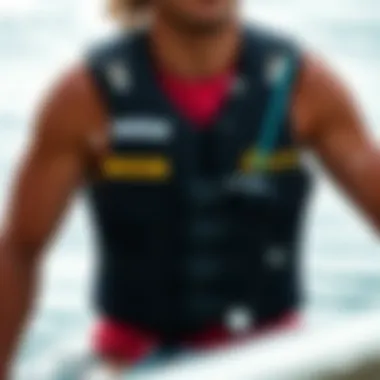
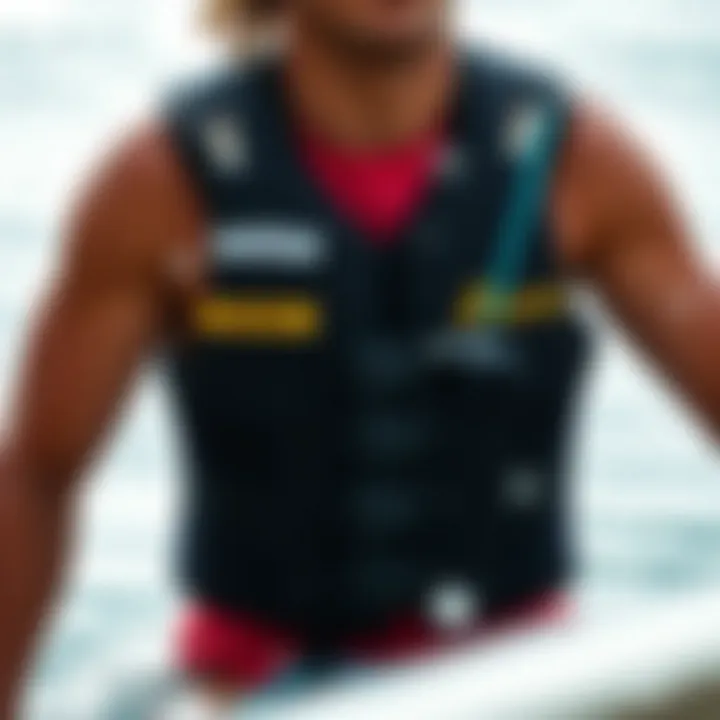
When it comes to flotation vests, the relationship between price and performance is a nuanced one. Here are key considerations:
- Budget-Friendly Options: Some brands offer basic flotation vests at competitive prices. These may sacrifice some features or aesthetics but often still meet safety standards.
- Mid-Range Investments: Mid-range vests generally provide a good balance between performance and cost. They often come equipped with additional features such as adjustable straps, ergonomic designs, and better buoyancy.
- Premium Products: High-end flotation vests tend to feature advanced materials and construction techniques, providing optimal buoyancy, comfort, and durability. These vests are designed for serious surfers who demand peak performance.
In this price-performance landscape, it’s crucial for surfers to consider not just the upfront costs but also the long-term benefits a quality vest can provide. A vest that may seem pricey at first may ultimately lead to better safety and more enjoyable outings.
Making an educated choice regarding flotation vests involves weighing these elements carefully. Surfers should contemplate how often they surf, their skill level, and specific conditions they encounter. With this tailored analysis, they can find a vest that suits their needs without breaking the bank.
Case Studies: Real-Life Use of Flotation Vests
Exploring the role of flotation vests in real-world situations sheds light on their importance in enhancing safety for surfers on the water. Through the experiences of various surfers, we can appreciate the benefits these vests offer in unexpected scenarios. Case studies reveal both the triumphs and pitfalls encountered, allowing other surfers to learn crucial lessons about the significance of wearing flotation vests.
Success Stories
In the waves of Hawaii, one enthusiastic surfer named Kyle shared his experience that highlights the vital impact of wearing a flotation vest. During a particularly aggressive session at Pipeline, Kyle had a wipeout that left him disoriented underwater. Luckily, the flotation vest he wore helped him surface more quickly than if he were unprotected. In his own words, "That vest was a lifesaver. Without it, I wouldn't have made it back to the surface as fast. It felt like I was being held down when the waves crashed. That buoyancy really came in handy!"
Kyle's story isn’t unique. Across various surf spots, many stories echo similar themes. Whether it’s the novice surfer hesitating on their first ride or a seasoned pro, flotation vests have proven advantageous in saving lives and providing crucial buoyancy during critical moments. It's clear that vests can be lifesaving tools in turbulent waters, reducing risk during unexpected mishaps.
A contribution from a competitive surfer, Maria, further corroborates this point. In a regional competition, she lost control while attempting an ambitious maneuver and found herself underwater momentarily. She recounted, "I was panicking, but as soon as I remembered I had my flotation vest, I instantly calmed down. I knew I wouldn’t have to fight for air as much." Maria's account reflects how flotation vests not only help in emergencies but also contribute to a sense of security for surfers, allowing them to push their limits with more confidence.
Lessons Learned from Failures
While success stories paint an optimistic picture, it’s essential to examine instances where flotation vests fell short of expectations. These lessons can inform surfers about potential shortcomings and the importance of making informed choices.
Take the case of Sam, who went out for the day wearing a flotation vest he purchased many years ago. He had decided it still looked good enough to use, but he didn’t check whether it met current safety standards. During a rough surf session, the vest failed to provide the buoyancy he needed after a heavy fall. Despite it being his normal routine to wear it, he was left struggling. In hindsight, Sam expressed, "I should've kept up with the standards. That was a painful lesson. It’s all good and well to have a vest, but it’s useless if it hasn’t been updated in years."
Similarly, a surfing group’s training session ended in a close call when one individual neglected to secure their flotation vest correctly. This oversight led to a moment where the vest slipped during a fall, causing panic. The surfer was fortunate, as they regained control quickly, but the experience served as a wake-up call for the entire group. They learned that fit and functionality go hand-in-hand.
These real-life scenarios illustrate indispensable lessons for all water enthusiasts. It's not only about investing in flotation vests but ensuring they are safe, secure, and fit for purpose regularly. In the waves, where danger often lurks, meaningful awareness often makes the difference between tranquility and chaos.
"In surfing, safety should never be compromised. A flotation vest should always feel like an extension of yourself, not just a piece of gear."
By examining both triumphs and challenges, surfers gather invaluable insights that can make all the difference when they hit the waves. The experiences shared in these case studies emphasize not just the value of flotation vests, but also the responsibility that comes with selecting and maintaining them.
Regulatory Standards and Compliance
Regulatory standards and compliance play a pivotal role in the manufacturing and usage of surfing flotation vests. These vests aren’t just fashion statements; they’re life-saving tools designed to keep surfers safe while riding the waves. Ensuring adherence to global safety regulations means that manufacturers must put forth vests that have undergone rigorous testing, thereby guaranteeing performance under various conditions. Failure to adhere to these standards can lead to subpar products that might not perform as expected when it counts.
Global Safety Regulations
The realm of water sports is governed by a labyrinth of international standards. Various organizations, such as the International Organization for Standardization (ISO) and specific regional agencies, develop guidelines to ensure flotation devices meet certain safety benchmarks.
For instance, it’s vital for flotation vests to achieve specific levels of buoyancy, which correlates directly with the user's weight and intended activity. Many countries have adopted these guidelines into legal requirements. For surfers looking to purchase flotation vests, it’s wise to check for certifications indicating compliance with recognized safety standards.
- ISO Compliance: Ensures the product meets basic safety requirements.
- CE Marking: In Europe, products must comply with health, safety, and environmental protection standards.
- U.S. Coast Guard Approvals: In the United States, certain vests are required to have a label indicating they meet the Coast Guard regulations.
Additionally, regulations also cover factors like the material used, durability of stitching, and the design’s capacity to withstand impact and prolonged use in water. All these elements come into play to foster a higher level of safety for surfers.
Impact on Manufacturing Practices
Manufacturers in the flotation vest industry must navigate through these regulations, making considerable adjustments to their production processes. Compliance doesn't just meet a legal requirement; it fosters consumer trust and market credibility. Vests that are built incorporating these regulations are less likely to fail, which can mean the difference between a safe ride and a potentially tragic incident.
Incorporating compliance from the ground up often leads to transformations in:
- Material Sourcing: Manufacturers may invest in higher-quality materials that are both buoyant and resilient under stress.
- Testing Procedures: Extensive testing protocols must be followed, from simulations of real-life conditions to stress tests that take into account factors such as UV exposure and water pressure.
- Design Innovations: As guidelines evolve, manufacturers are encouraged to innovate further, creating vests that are not only safe but also lightweight and comfortable for long durations.
"Safety in water sports isn’t just an option; it’s a necessity. Regulatory standards drive quality in flotation vests that could save lives."
By aligning their practices with these frameworks, manufacturers contribute to a safer surfing environment, allowing surfers to focus on enjoying the waves instead of worrying about their safety equipment.
The Future of Surfing Flotation Vests
The realm of surfing flotation vests stands at a pivotal juncture, with advancements in technologies and heightened environmental awareness steering the course of future developments. As water sports continue to grow in popularity, ensuring that surfers are safe and comfortable is paramount. The future promises not just enhancements in safety but also a shift toward eco-friendly practices.
Technological Innovations
The integration of smart technology in flotation vests is transforming how surfers engage with their equipment. We’re no longer just talking about buoyancy; vests are evolving to incorporate features like GPS tracking, which can be invaluable during a session in perilous conditions. Surfers can have peace of mind knowing that if they run into trouble, help can be summoned with the press of a button.
Furthermore, materials are evolving. Advanced foams that provide excellent buoyancy while being lightweight are already hitting the market. This lightweight quality can drastically improve comfort and performance. Some manufacturers are experimenting with self-inflating technologies that can automatically deploy under certain conditions—for instance, if the vest senses a fall or an unusual level of impact.
Also notable is the rise of wearable technology—think heart rate monitors built into the vest fabric. These would not only keep surfers updated on their physical state but also ensure they don’t push their limits too far, which is crucial in environments where conditions can change in a blink.
Sustainability Considerations
As we peer into the future of surfing flotation vests, sustainability looms larger on the agenda. The environmental impact of using synthetic materials is a growing concern. Biodegradable materials—such as those derived from algae or recycled plastics—are being explored by innovative companies eager to reduce their carbon footprint. This move not only addresses environmental issues but also resonates with a generation of surfers who are more conscious than ever about their ecological impact.
It’s also possible that innovations in production methods will lead to reduced waste. Manufacturers are increasingly looking at digitized design processes that minimize excess materials. This not only cuts down on trash but can also streamline production, potentially making high-quality flotation vests more accessible to a broader audience.
Culmination
In the realm of surfing, flotation vests serve a vital purpose that is often overlooked until the need arises. As this guide highlights, the benefits of employing a flotation vest are manifold. It’s not just about staying afloat; it’s about enhancing overall safety, boosting confidence in the water, and potentially saving lives.
The technicalities covered in previous sections stress the importance of understanding your own buoyancy needs and how different vests cater to various surfing conditions. From the quiet, serene waters to the thrashing waves, choosing the right flotation vest is a personal endeavor that balances comfort, fit, and safety features. It becomes even more critical in competitive settings, where every second counts and the waters can be unforgiving.
Moreover, considerations around the durability and maintenance of these vests cannot be ignored. Regular care ensures that the vest functions optimally when it’s needed most. Properly maintaining it—by cleaning and storing away from harsh elements—can significantly extend its life, providing not just value but peace of mind.
"In water sports where the unexpected is waiting just beneath the surface, a flotation vest is more than gear; it’s a lifeline."
Additionally, as we explored the landscape of future innovations, one can't help but recognize the ongoing advancements aimed at enhancing safety without impeding performance. Technologies integrating sustainability will also shape the future, aligning with the growing awareness of environmental impacts—factors that surfers, travelers, and outdoor enthusiasts increasingly prioritize.
In essence, while surfing can be exhilarating, the responsibility lies with the individual surfer to equip themselves with the proper safety gear. Flotation vests are not merely accessories; they are essential components of the surfing experience. Understanding their importance, characteristics, and maintenance can dramatically influence not only one’s enjoyment but also safety during those unforgettable moments on the water. Therefore, consider this not just a concluding statement but a vital reminder to invest wisely and surf safely.















